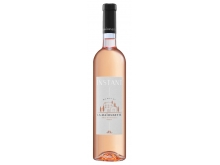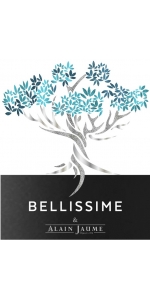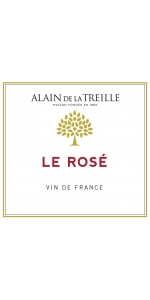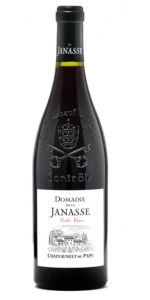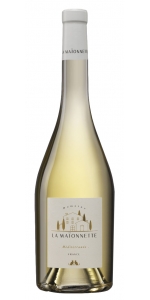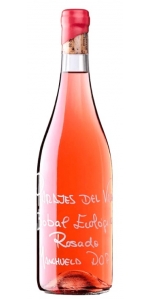Domaine La Maionnette Rose Cotes de Provence 2024
| Country: | France |
| Region: | Provence |
| Winery: | Maionnette |
| Grape Type: | Syrah |
| Organic: | Yes |
| Vintage: | 2024 |
| Bottle Size: | 750 ml |
All older vintage wines have been purchased from a single collectors cellar. Pictures can be requested before shipment.
Alain Jaume Bellissime Cotes du Rhone Rose is made from 50% Grenache Noir, 25% Cinsault, 20% Syrah and 5% Mourvedre
Salmon-pink color, clear and brilliant. The nose is fruity and spicy, reminiscent of wild strawberry and fine Provencal spices. The palate is full, well-balanced and fruity, with a long, fresh finish. A beautiful and delicate rosé.
A part is drawn off the skins with short maceration and the other part is from direct press. Fermentation in stainless steel at cool temperature. Bottling 5 months after harvest.
This dry Rosé is very aromatic on the fruitiness with a great style and elegance.
Average age of the vines is 25 years old.
We produce a part of this cuvee with 12 hours skin maceration and another part from directly pressed grapes.
Wine was slightly filtered before bottling to insure the wine remains stable.
This wine is the perfect friend for barbecue, salads and of course aperitif. This is ideal for warm days in the garden, as well as elegant poultry dishes.
Domaine de la Janasse Chateauneuf-du-Pape Cuvee Vieilles Vignes is made from 65% Grenache, 20% Mourvèdre, 10% Syrah, 5% divers.
In contrast to Chaupin, which is made from old-vine Grenache on sandy soils, the cuvée Vieilles Vignes is from old vines of Grenache, Mourvedre, Syrah along with smaller percentages of other permitted varieties that are grown in these old vineyards. The wine is sourced from 4 terroirs: pebbly clay, sand, gravelly red clay and sandy limestone. Vieilles Vignes is always the most powerful and concentrated Châteauneuf-du-Pape cuvée made at Domaine de la Janasse.
Review:
The advantages of old vines are perhaps most evident in the more difficult vintages (whether hot and dry or cool and rainy). The 2021 Chateauneuf du Pape Vieilles Vignes is a strong effort, delivering supple, velvety waves of ripe black cherries and black raspberries. Medium to full-bodied, it's rich and concentrated without seeming at all heavy or unbalanced, finishing long and juicy. It's approximately 75% Grenache, 15% Mourvèdre, 5% Syrah and 5% other varieties, keeping in mind that up to 15% of the old Grenache vines are actually Clairette Rose.
-Wine Advocate 96 Points
Maionnette Mediterranee Blanc is made from 30% Rolle, 30% Viognier, 20% Semillon and 20% Sauvignon Blanc.
Domaine de la Maïonnette is produced from grapes benefiting from an ideal location next to the river and planted on a clay-limestone based soil with a silty character, which brings suppleness, roundness and lightness to the wines.
La Maionnette is a brilliant straw yellow colored white offering delicate aromas of citrus fruits, and fresh notes of pear and apricot. Rich and round on the palate, and a good balance.
Parajes del Valle Manchuela Bobal Ecologico Rose is an organic 100% Bobal Rose.
Floral and fresh wine. Excellent option to combine with cheese goat and walnuts salad, or with a platter of smoked salmon.
Domaine La Maionnette Rose Cotes de Provence is made from 60% Syrah, 20% Cinsault and 20% Grenache.
The plots of Domaine de la Maïonnette benefit from a clay-limestone soil and are located on a plateau surrounded by hundred-year-old oaks. Bordered by the Provencal scrubland, the vineyard enjoys a dry climate typical of the region.
An emblematic cuvée of the estate, this Cotes de Provence rosé reveals concentrated aromas of citrus fruits and white flowers, and a beautiful structure. The fresh palate brings out sweet candy notes, gooseberry and litchi, and delivers bright acidity and ample length on the finish.
Located in La Crau, a few kilometers from Pierrefeu, Domaine de La Maïonnette spreads on a 30 hectare-vineyard where the wines are grown with passion to express the best of its terroir. La Maïonnette has been an independent winegrower since 1913.
The vines are equally divided between two appellations: AOP Côtes de Provence and IGP Méditerranée.
In addition to the traditional rosé wines of Provence, Domaine de La Maïonnette offers high quality white and red wines.
The estate benefits from a Mediterranean climate, where winters are rigorous and allow the vine to regenerate more easily, and summers are hot, providing a beautiful maturity to the grapes. The sea breeze avoids radical changes in temperature.
The wines of Domaine de la Maïonnette reflect the elegance of the Provençal terroir, characterized by the hot and dry climate. The clay-limestone based soils represent an ideal place to grow the grapes thanks to their ability to retain the water better, while bringing body and power to the wine, and leaving them supple and round.
The night harvest - that favors the freshness of the aromas - and the vinification are also thought to enhance the quality of the grapes ripening under the Mediterranean climate.
The Malard family has been rooted in wine for 3 generations. In the 90s, Jean-Louis Malard developed his own Champagne wines. He quickly became one of the major players in the Champagne landscape. Passionate about wine and driven by entrepreneurship, he's always in the search for new challenges around his passion. Attached to the Provence region and the quality of the wines produced there, purchasing Domaine de La Maïonnette was the perfect match and the result of a long research and meticulous work.
- back
Opulent floral top notes carry you into an opaque purple core, imparting aromas of black currants, dark red cherry coulis, cigar box, and allspice berries. Powerful yet soft tannins are balanced with a delightful freshness of acidity. The palate is silky with nuanced flavors of cassis, ripe blackberry, and Morello cherry. The long finish invites you to discover the wine’s evolving layers.
Review:
This is, as usual, a beauty, perhaps more so thanks to a great vintage. It is classically Napa Valley, and classically “house styled” by Aron Weinkauf, with black and blue fruit, supple, approachable tannin structure and great depth of aroma and flavor. That said, keep in mind that this isn’t the winery flagship offering. Even in this price range Lyndenhurst is always a solid value, and is so again – maybe even a little more than usual. Decant well if you crack into this in the near term, or age it for the long term. Contains 10.6% Merlot, 3.8% Petit Verdot, 3.5% Cabernet Franc and 2.9% Malbec. (Rich Cook)
- Wine Review Online 95 Points
A juicy red with black currants and balsamic. Bark and mushroom. Iodine, too. Medium body, creamy texture that tightens at the end. An energy and firmness in the finish.
-James Suckling 94 Points
Dominique Piron Morgon Cote du Py is made from 100 percent Gamay.
The Morgon Cru is based in the heart of Northern Beaujolais. Côte du Py is the heart of Morgon, a little hill of very old blue stone rocks - the oldest soils of Beaujolais (around 430 millions years old), with a typical blue color.
Côte du Py has been known for centuries for being the best terroir of the village, producing long lived wines with strong structure and flavors.
Wines of the Côte du Py are very dark, profound and dense. Classic aromas of red berries, cherry, kirsh. Fruity, structured and mineral in the mouth with graphite flavors and spicy notes of black and white pepper. Wine can age up to 10 years.
Hand picked grapes are sorted manually and destemmed for 50 to 70%. Fermentation starts in concrete tanks and lasts for 18-25 days with remontages and pigeages. Then after pressurage starts the aging, for 2/3 in concrete tanks, and 1/3 in recent French oak barrels with batonages on fine lies only. After 10 month we do the blending, keeping only the best cuvees and best barrels, and do the bottling.
Pairs well with red meat like beef, duck and game (Hare, Dear, Wild Pork,…), cheses.

